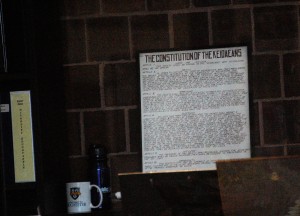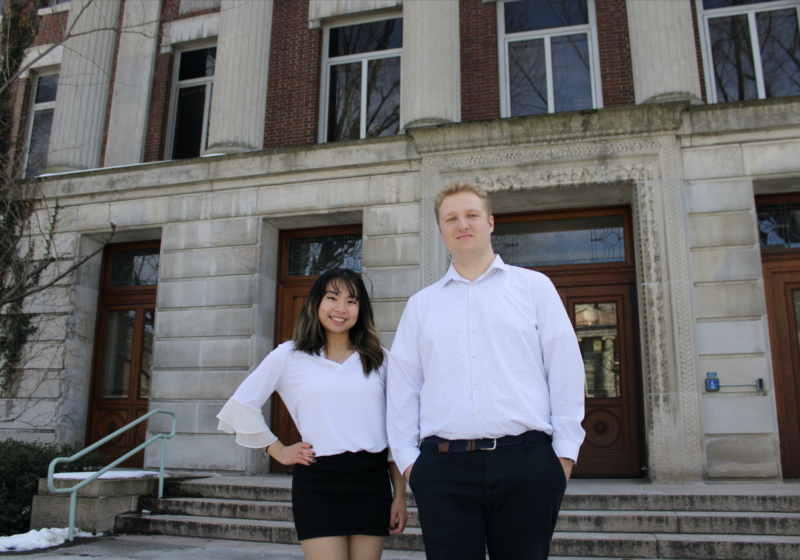It starts with a letter. It always does.
“Be on Anderson Circle on Sunday afternoon on [this date] at [this time]. Have in your possession $10 for initiation fee. Dress warm and in your old clothes. Show this to no one,” it read. The letter was just this simple message on one side. The other side bore a large, red “K” with an arrow through it. This is the invitation to the Keidaean Honor Society.
The letter will be slipped beneath the door of just over a dozen unsuspecting juniors at UR, chosen due to their involvement in on-campus student organizations. A Campus Times article from April 18, 1924, establishes that membership into the honor society is based on “merit and not on personal preferences; participation in activities and excellent in scholarship determining the number of points scored by each student.” This point system is assigned to notable members of each class and used to determine which juniors will be invited or “tapped” to join.
Records of the Keidaean Honor Society date back to 1924, when Dr. Elliot Parker Frost, a professor and chairman of psychology at UR, and former professor at Dartmouth College, approached five juniors — Merc Brugler, Clarence Henry, James Gray, Carl Lauterbach, and Joseph Leone — about starting an honor society to “further the spirit of cooperation and fraternity at the University.”
Frost, along with Brugler, Henry, Gray, Lauterbach, and Leone, consequently crafted the organization’s first constitution, titled “Historical Sketch – Keidaeans,” which sketched out the group’s initiatives, history, and governing laws.
The Keidaeans were originally public and well received. Campus Times covered the group on several occasions throughout the 1920s. In one such article, published May 2, 1924, Packard, a history professor from 1920-25, said, “I think the system of selecting members according to points for their activities will prove efficient. Perhaps it could become secret later.”
The “Historical Sketch,” as stated in 1924, noted that although “the purposes of Keidaeans are openly stated, the machinery of its government, its discussions, the details of its organization, its customs, and rites remain within the confidence of its members,” and that, “the names of the officers shall not be disclosed.”
Yet in the Internet age, it is hard to keep anything a secret. A Google search will lead even an amateur to a number of primary sources: a number of Rochester Alumni Reviews from the 30s naming the junior members tapped that spring, features on UR Athletics’ website that mention the athletes’ participation in the group, and even LinkedIn profiles of UR members, past and present.
The level of awareness students have regarding the society today, nearly a century after its creation, varies greatly.
“I have never heard of the Keidaeans,” said sophomore Brad Kowalczyk said, “I had no idea about it.”
Yet others give the impression that they are more than aware of the organization and respect its ultimate goal of confidentiality.
Most Keidaean alumni who were contacted declined to comment, but one alumnus responded that he would answer questions as long as he remained anonymous. He ignored the subsequent attempts of communication.
Though unaffiliated with the Keidaeans, graduate student James Meyers claims to have witnessed an initiation ceremony when his friend, whose name will remain undisclosed by request, was inducted four years ago. After his friend received the marked letter, Meyers and three acquaintances staked out overnight in Douglass Dining Hall, keeping a watchful eye on Dandelion Square.
“After a few minutes, ordinary students began to gather by a bench,” Meyers recalled of the night. “We grew excited by the prospect of this actual secret event taking place, all of the student myths were morphing into realities right before our eyes.”
Meyers said students continued to congregate around the bench until about 15 students had gathered. An additional student joined the group and seemed to be in charge. It was then that Meyers and his friends followed this group of students up to the benches in the middle of Eastman Quad — Anderson Circle.
“All of the dark figures, blanketed by black robes, approached the circle, their faces covered. They seemed to float to their destination,” Meyers recollected. “A ring of students interlaced with hooded creatures was positioned in a circle at the center of the quad.”
By showing up to this ceremonial ‘tapping’, juniors accept the invitation to the society and receive a pin with the Keidaean emblem. Induction into the Keidaeans means continued service to the University while working closely with administration. Many past deans of the University have been part of the Keidaeans, and the group is used largely to solve problems that either party recognizes in the college. Their Historical Sketch notes that the group “studiously avoids taking a stand on any issue.” Rather, “the modus operandi is quiet persuasion as manifested by its members in their positions of respect and leadership in other campus organizations and activities.”
Many of the problems, as described in the meeting minutes between 1924 and 1964, were similar to challenges students and administrators face today: improving the standing of UR, increasing participation in student groups, allowing alcohol at more University functions, and increasing the number of parking spaces available on campus. Some things never change.
Though the organization remains a rich part of the university’s history, the lack of student awareness almost undermines the prestige that surrounds being inducted into the Keidaean Honor Society. Perhaps the real honor lies in something intrinsic, something more — something secret.
Arre is a member of
the class of 2015.





